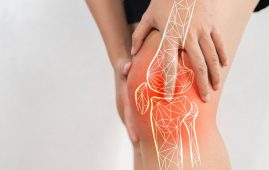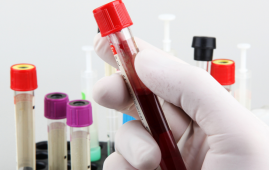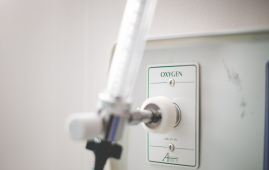

The first wearable sensor created by researchers at The Ohio State University is intended to detect and track muscle atrophy. Muscle atrophy, a disorder characterized by a decrease in skeletal muscle mass and strength, can occur for a number of reasons but is often a side consequence of aging, degenerative disease, or muscle inactivity.
Although doctors presently use MRI to determine whether a patient’s muscle volume and size have decreased, routine testing can be time-consuming and expensive. Yet according to this recent study, which was published in the journal IEEE Transactions on Biomedical Engineering, an electromagnetic sensor made of conductive “e-threads” might be used as a substitute for routine MRI monitoring. Researchers created 3D-printed limb molds and filled them with ground beef to mimic the calf tissue of a typical-sized human participant in order to corroborate their findings. Their research demonstrated that the sensor could track muscle loss of up to 51% and assess minute volume changes in total limb size.
“Ideally, our proposed sensor could be used by health care providers to more personally implement treatment plans for patients and to create less of a burden on the patient themselves,” said Allyanna Rice, lead author of the study and a graduate fellow in electrical and computer engineering at The Ohio State University.
The study draws on Rice’s earlier work developing health sensors for NASA and represents the first known method of measuring muscle atrophy using a wearable gadget. The space agency is interested in keeping an eye on astronauts’ health in a number of ways because prolonged space travel frequently has negative effects on the human body.
This study was motivated by the desire to find solutions to the health problems faced by astronauts, which has motivated researchers to spend decades trying to understand and battle these impacts. For instance, while researchers are aware that even crew members on brief space voyages can lose up to 20% of their muscle mass and bone density, there isn’t much information on the potential health effects of staying in space for much longer missions, according to Rice.
“Our sensor is something that an astronaut on a long mission or a patient at home could use to keep track of their health without the help of a medical professional,” she said.
Yet, it is easier said than done to develop a wearable device that can precisely measure minute muscle changes in the human body. The gadget was created by Rice and her co-author Asiminia Kiourti, an Ohio State professor of electrical and computer engineering. They used two coils—one for transmitting and the other for receiving—as well as an e-thread conductor to give the fabric a particular zig-zag pattern.
Rice said it was initially difficult to create a pattern that would allow for a wide range of alterations to the size of the sensor’s loop so it could fit a big section of the population, even though the finished result resembles a blood pressure cuff. “When we first proposed the sensor, we didn’t realize that we would need a stretchable material until we realized that the person’s limbs were going to be changing,” she said. “We need a sensor that can change and flex, but it also needs to be conformal.”
After some trial and error, they discovered that zig-zagging was the best way to increase flexibility rather than sewing in a straight line, which would have limited it. The sensor may be scalable over many body parts, or even multiple sites on the same limb, due to the same innovative pattern.
The study states that although the wearable is still years away from being put into use, the next significant step would probably be to connect it to a mobile app, which could be used to record and communicate health information directly to healthcare specialists.
And to improve life for future patients both on Earth and in space, Rice is looking forward to combining the sensor with other kinds of devices for detecting and monitoring health issues, such as a tool for detecting bone loss.
“In the future, we would like to integrate more sensors and even more capabilities with our wearable,” Rice said.
more recommended stories
 New Blood Cancer Model Unveils Drug Resistance
New Blood Cancer Model Unveils Drug ResistanceNew Lab Model Reveals Gene Mutation.
 Osteoarthritis Genetics Study Uncovers New Treatment Hope
Osteoarthritis Genetics Study Uncovers New Treatment HopeOsteoarthritis- the world’s leading cause of.
 Antibody Breakthrough in Whooping Cough Vaccine
Antibody Breakthrough in Whooping Cough VaccineWhooping cough vaccine development is entering.
 Scientists Unveil Next-Gen Eye-Tracking with Unmatched Precision
Scientists Unveil Next-Gen Eye-Tracking with Unmatched PrecisionEye-tracking technology has long been a.
 Men5CV: Hope for Ending Africa’s Meningitis Epidemics
Men5CV: Hope for Ending Africa’s Meningitis EpidemicsA landmark global health study led.
 Stem Cell Therapy Shows 92% Success in Corneal Repair
Stem Cell Therapy Shows 92% Success in Corneal RepairA groundbreaking stem cell therapy known.
 Gene Therapy for Maple Syrup Urine Disease
Gene Therapy for Maple Syrup Urine DiseaseResearchers at UMass Chan Medical School.
 How Fast Are Your Organs Aging? Simple Blood Test May Tell
How Fast Are Your Organs Aging? Simple Blood Test May TellNew research from University College London.
 HEALEY Platform Accelerates ALS Therapy Research
HEALEY Platform Accelerates ALS Therapy ResearchA New Era of ALS Clinical.
 Low-Oxygen Therapy in a HypoxyStat Pill? Scientists Say It’s Possible
Low-Oxygen Therapy in a HypoxyStat Pill? Scientists Say It’s PossibleA New Approach to Oxygen Regulation-HypoxyStat.

Leave a Comment